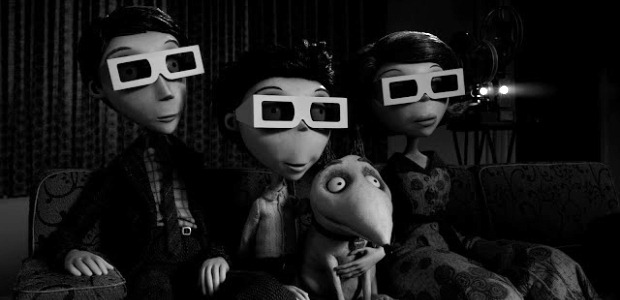For a stop-motion animated film, Frankenweenie has a lot of things going for it. Comprising of over 200 puppets strung to about 30 individual puppeteers, the result is a top notch, fluid animated feature that is very realistic to the naked eye. What is surprising is the fact that it took director Tim Burton two years to literally animate the story of a boy and his dog and the bond they share – an incredible feat when considering that a week of filming produces only five seconds of animation!
Entirely shot in black and white, the setting is perhaps Burton’s greatest triumph – a throwback to Hollywood’s past while experimenting with the undead. Set during 1970s in the town of New Holland, it is the story of young Victor Frankenstein (Charlie Tahan) and his beloved dog Sparky. As is typical of boys his age, Victor loves his dog and even uses Sparky as the protagonist in his home-made stop motion animated films. All this changes the day Sparky is killed in a tragic accident. Inspired by his science teacher, Victor does the inevitable. Sparky is resurrected (no surprise, given the title) but soon attracts the curiosity of his classmates, who are all vying for the ultimate science fair project. Once they figure out how Victor brings Sparky back to life, clandestine trips to the pet cemetery results in grotesque consequences for the sleepy town of New Holland.
With a fascination for the macabre and the morbid, I can’t say this is Tim Burton at his best, nor his most original. No doubt, filming a stop motion animation in black and white, and in 3D, is a cinematic first but there are too many similarities to his 2005 animated film Corpse Bride, another stop motion film dealing with, well, the undead. The characters (or puppets) look almost identical with Burton relying on his signature gothic dark circled eyes. Curiously, Sparky looks almost the same before and after his death. When it comes to originality, there’s not much you can expect in terms of the story when the premise itself is an obvious homage to the 1931 classic, itself inspired and titled after Mary Shelley’s seminal Frankenstein story. Knowing this, the black and white setting becomes a necessary aspect and a vital component in Burton’s grand scheme of things. Another questionable flaw is the film’s juvenile PG rating. Given the premise of Victor, his class mates, and their collective morbid curiosity, few children watching the film are going to be entertained. The bigger question is whether children are old enough to be entertained or fascinated when dealing with the subject of death or the possibility of life after death. Although there are funny moments, albeit very few and very dark, the subject shifts to an illustration telling children how to deal with the death of a pet and the ensuing process of letting go. Yet somehow, this does not appear to be the intended message if Sparky is meant to be brought back…more than once.
Considering its absolute scope and production value, Frankenweenie can be justified as a painstaking film made with grand ambition. There is also Burton’s panache for anything that goes bump in the night with various references to the early days of cinema monstrosities. To this effect, Danny Elfman’s score is a perfect consummation further accentuating Burton’s moments of intentional homage. And considering the sheer nature of its making, this film is a marvel to watch and recommended for a mature audience but not necessarily for kids. Speaking of which, there used to be a time in modern cinema when children were told not to try at home what they saw at the movies. But going by the last scene, Burton seems to be saying that it’s ok for kids to go back home, dig up a dead cat, stick kitty’s tail in the wall socket and yell “It’s alive, it’s alive!!”
Rating: 




